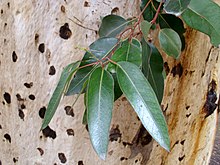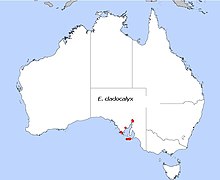Eucalyptus cladocalyx
| Eucalyptus cladocalyx | ||||||||||||
|---|---|---|---|---|---|---|---|---|---|---|---|---|

Eucalyptus cladocalyx |
||||||||||||
| Systematics | ||||||||||||
|
||||||||||||
| Scientific name | ||||||||||||
| Eucalyptus cladocalyx | ||||||||||||
| F. Garbage. |
Eucalyptus cladocalyx is a species ofthe myrtle family (Myrtaceae). It occurs on the south coast of Victoria , in the southeast of South Australia and north of Perth and as an invasive plant in Western Australia ; it is called "Sugar Gum" there.
description
Appearance and leaf
Eucalyptus cladocalyx grows as a tree that can reach heights of up to 15 meters. The bark is smooth, patchy gray, white or yellow all over the tree. There are oil glands in both the bark and the marrow of the young branches.
In Eucalyptus cladocalyx , heterophyllia is present. On middle-aged specimens, the leaf blades of the sitting leaves are lanceolate, curved sickle-shaped, with entire margins and matt gray-green. The leaf stalks on adult specimens are narrowly flattened or channel-shaped. The leaf blades on adult specimens are shiny green in different colors on the upper and lower sides, are lanceolate, curved sickle-shaped, relatively thick, taper towards the base of the blade and have a pointed upper end. The raised lateral nerves can come off the median nerve at an obtuse or acute angle. The cotyledons ( cotyledons ) are upside-kidney-shaped.
Inflorescence and flower
On the side of an inflorescence stem that is round in cross section, there are seven to eleven flowers in a single inflorescence . The flower buds are cylindrical or urn-shaped and not floured or frosted blue-green. The sepals form a calyptra that falls off early. The smooth calyptra is hemispherical, as long as the ribbed flower cup (hypanthium) and wider than this. The flowers are white or creamy white. The flowering period in Western Australia ranges from December or January to March or April.
fruit
The fruit is egg-shaped or urn-shaped. The disc is indented, the fruit compartments are included.
Occurrence
The natural range of Eucalyptus cladocalyx is in the southeast of South Australia , reinforced around Adelaide , and on the south coast of Victoria .
In Western Australia , Eucalyptus cladocalyx occurs exclusively in the independent administrative district of Subiaco in the city of Perth . In Western Australia, Eucalyptus cladocalyx is considered an invasive plant and is being controlled.
Eucalyptus cladocalyx grows on sandy soils over clay as well as on brown clay loam . Eucalyptus cladocalyx is found mainly in plains and on gentle slopes.
Systematics
The first description of Eucalyptus cladocalyx was made in 1853 by Ferdinand von Mueller , entitled Diagoneses et desriptiones plantarum novarum quas in Nova Hollandia in Linneaea , Volume 25, page 388. The type material has the inscription " Ad bases montium Marble range legit cl. C. Wilhelmi ”. Synonyms for Eucalyptus cladocalyx F.Muell. are Eucalyptus langii Maiden & Blakely and Eucalyptus corynocalyx F.Muell. nom. illegal.
Natural hybrids between Eucalyptus cladocalyx and Eucalyptus peninsularis have been found.
Web links
Individual evidence
- ↑ a b Specimen search results: Eucalyptus cladocalyx at Australia's Virtual Herbarium. Council of Heads of Australasian Herbaria . Retrieved March 15, 2013
- ↑ a b c d APNI = Australian Plant Name Index . Center for Plant Biodiversity Research. Australian Government. Retrieved March 15, 2013
- ↑ a b c d e Eucalyptus cladocalyx at EucaLink - A Web Guide to the Eucalypts . Last accessed on May 28, 2013.
- ↑ a b c d e Eucalyptus cladocalyx in the Western Australian Flora . Retrieved March 15, 2013.
- ↑ Eucalyptus cladocalyx at Tropicos.org. Missouri Botanical Garden, St. Louis, accessed March 15, 2013.
- ↑ Rafaël Govaerts (Ed.): Eucalyptus cladocalyx. In: World Checklist of Selected Plant Families (WCSP) - The Board of Trustees of the Royal Botanic Gardens, Kew . Retrieved March 15, 2013.


